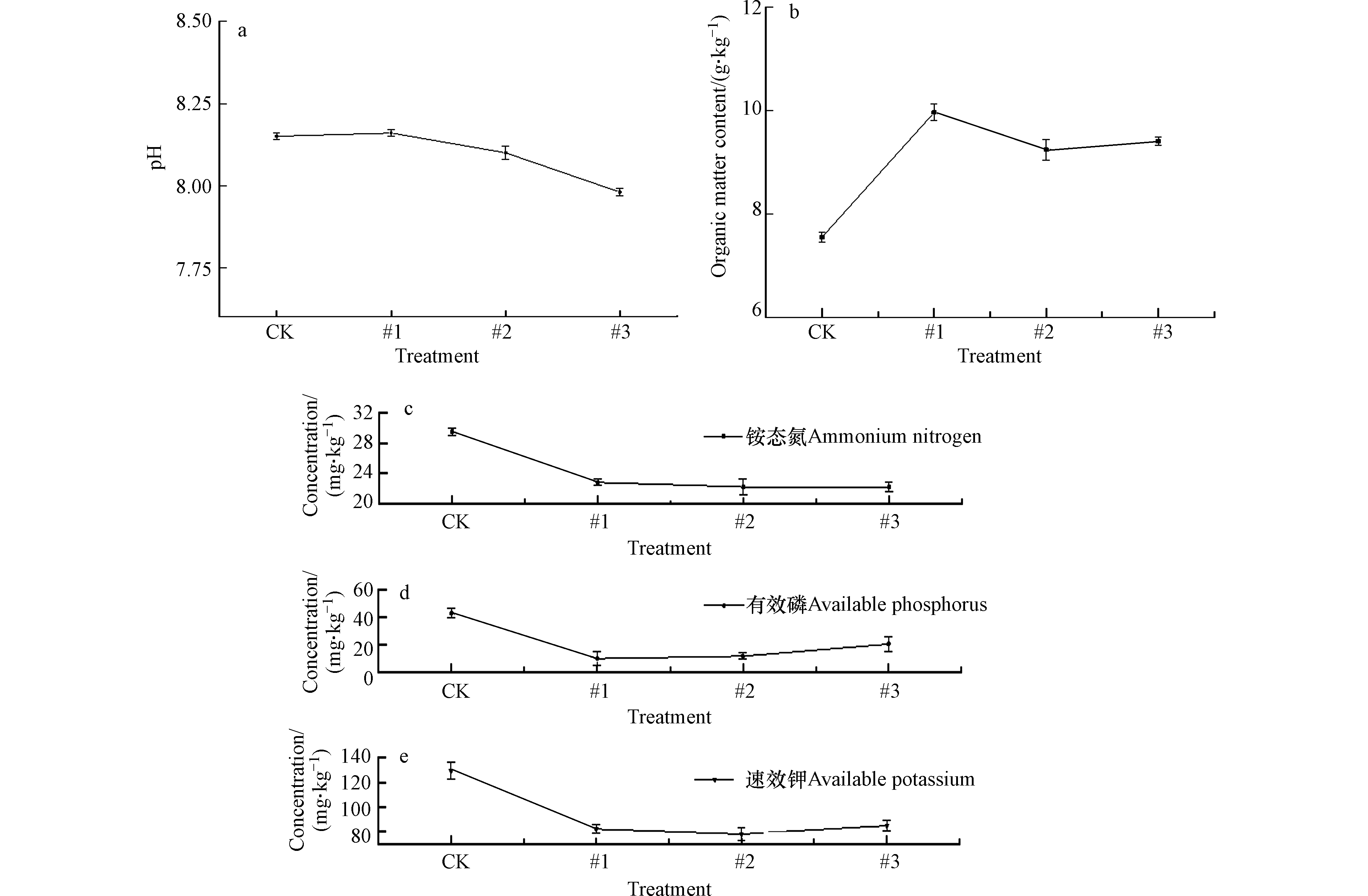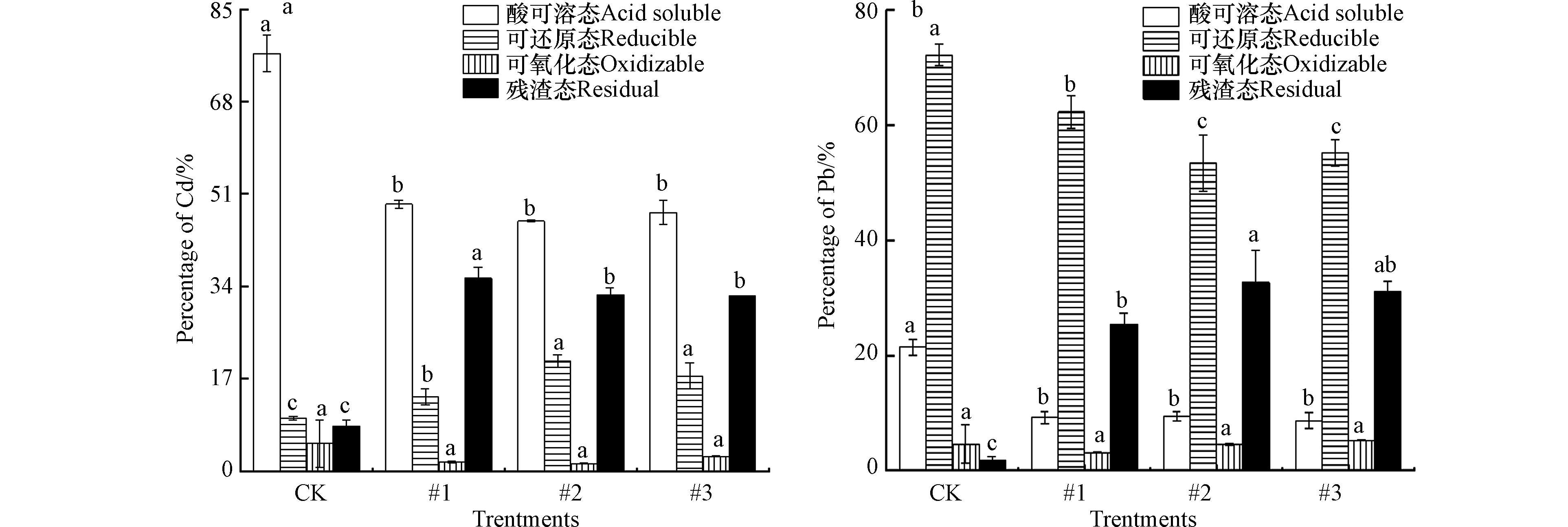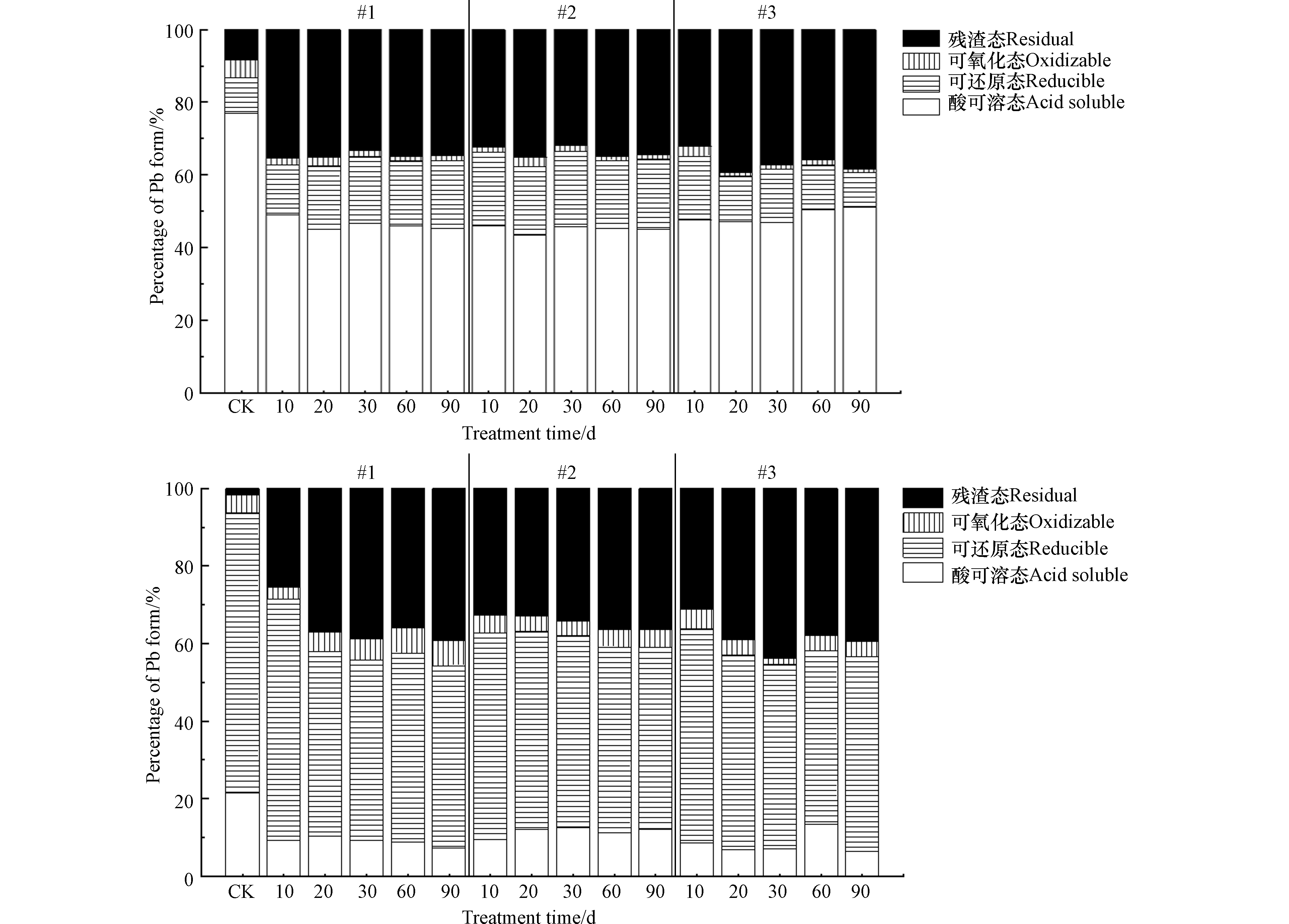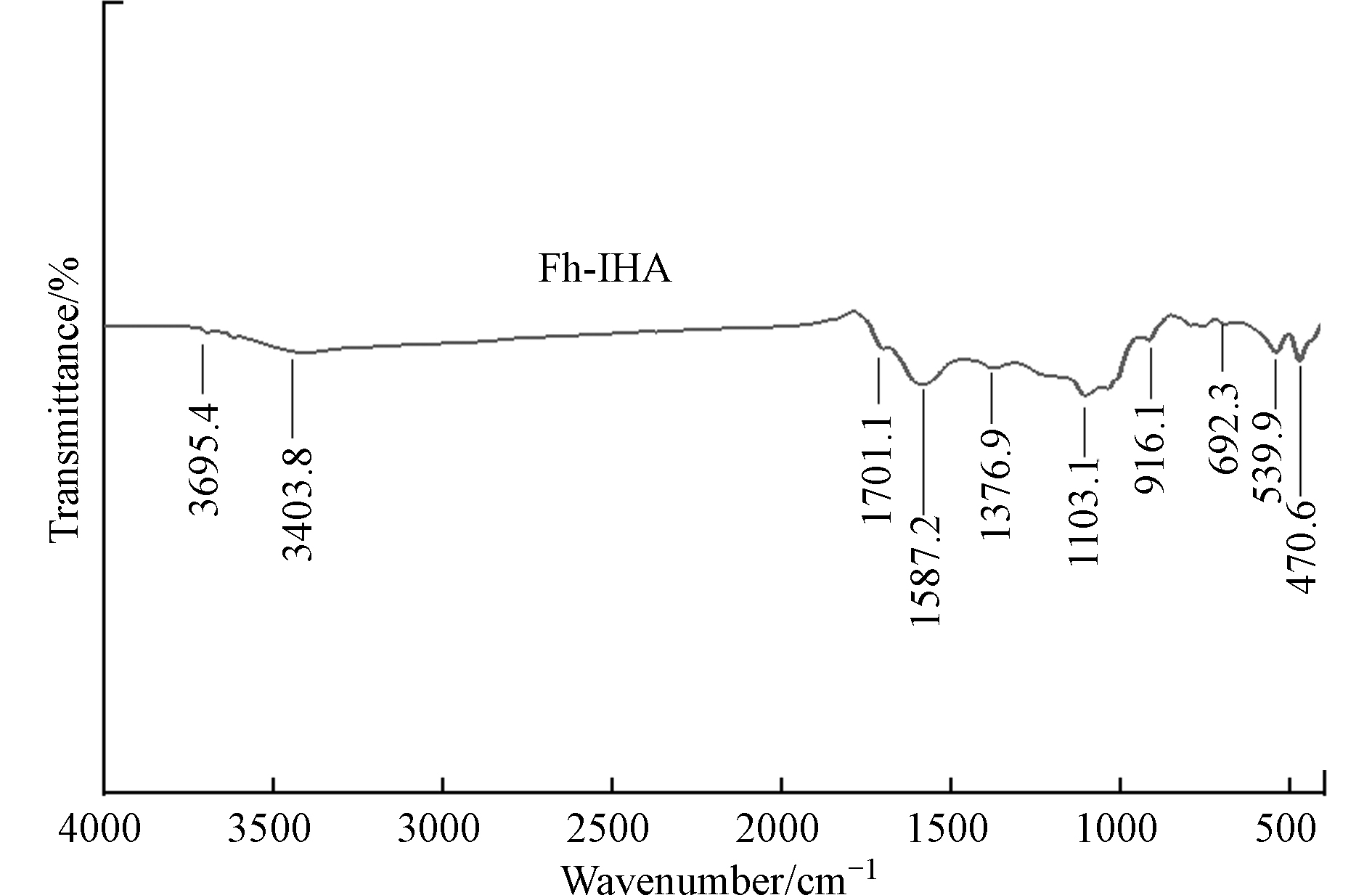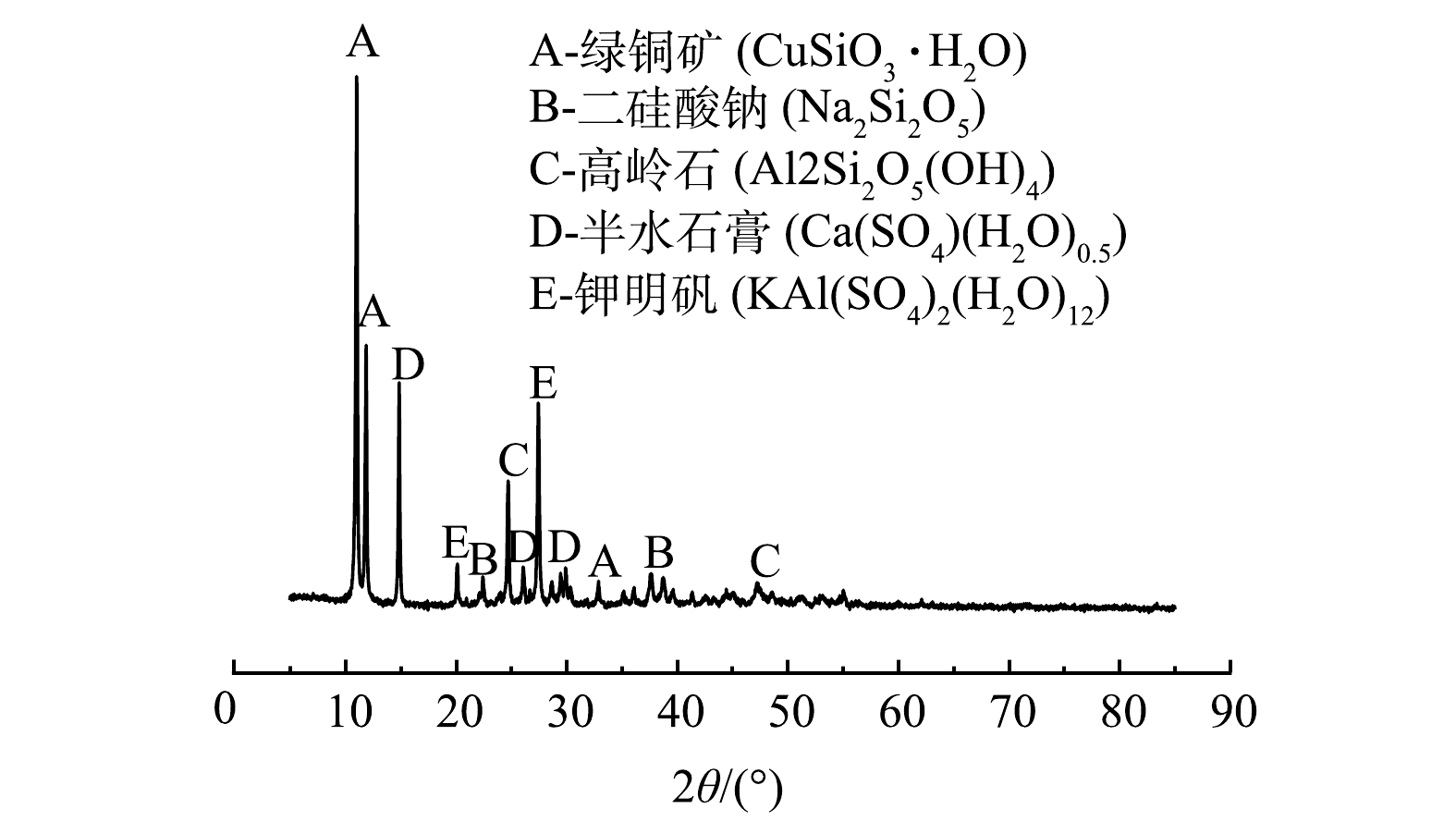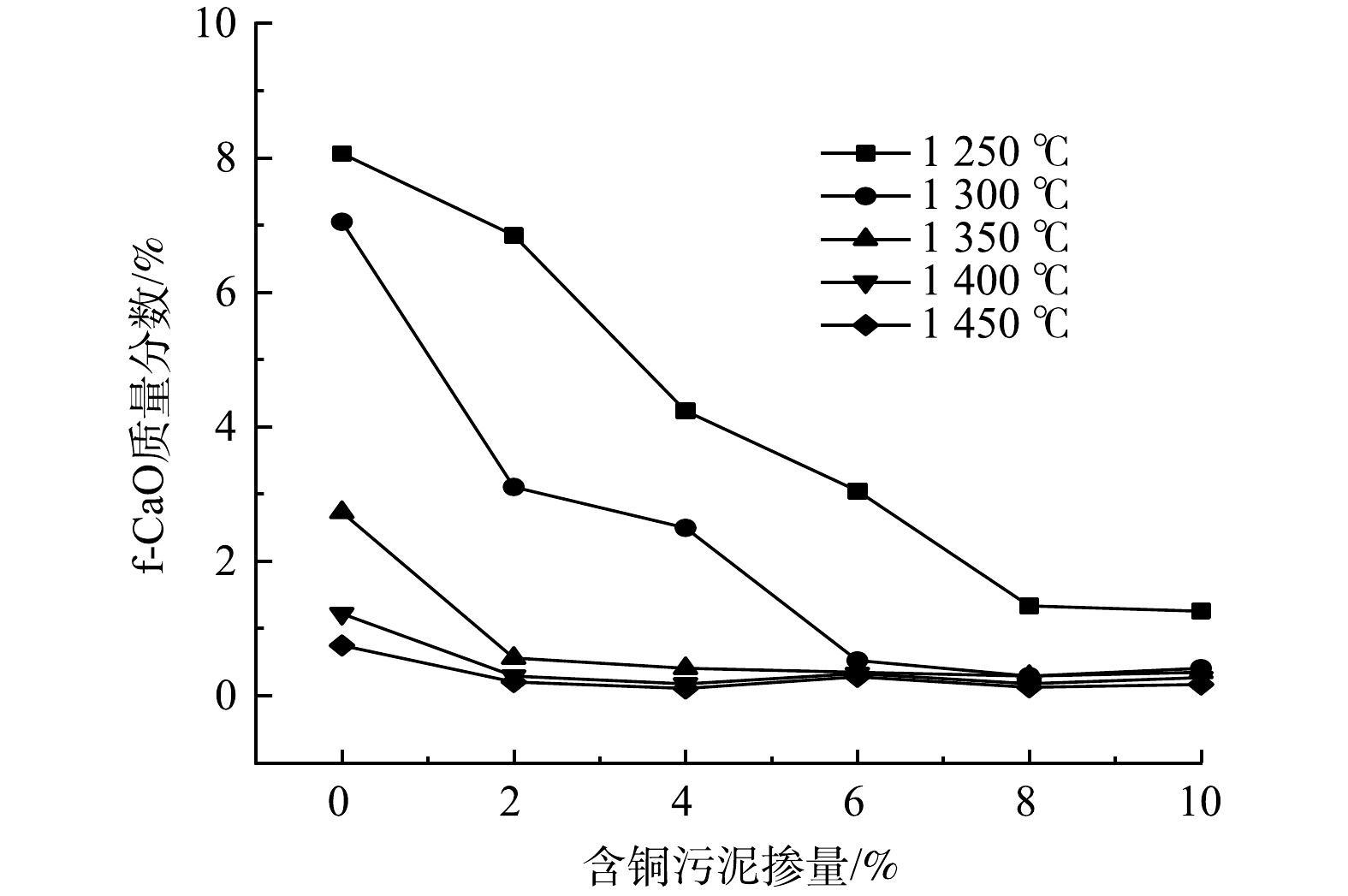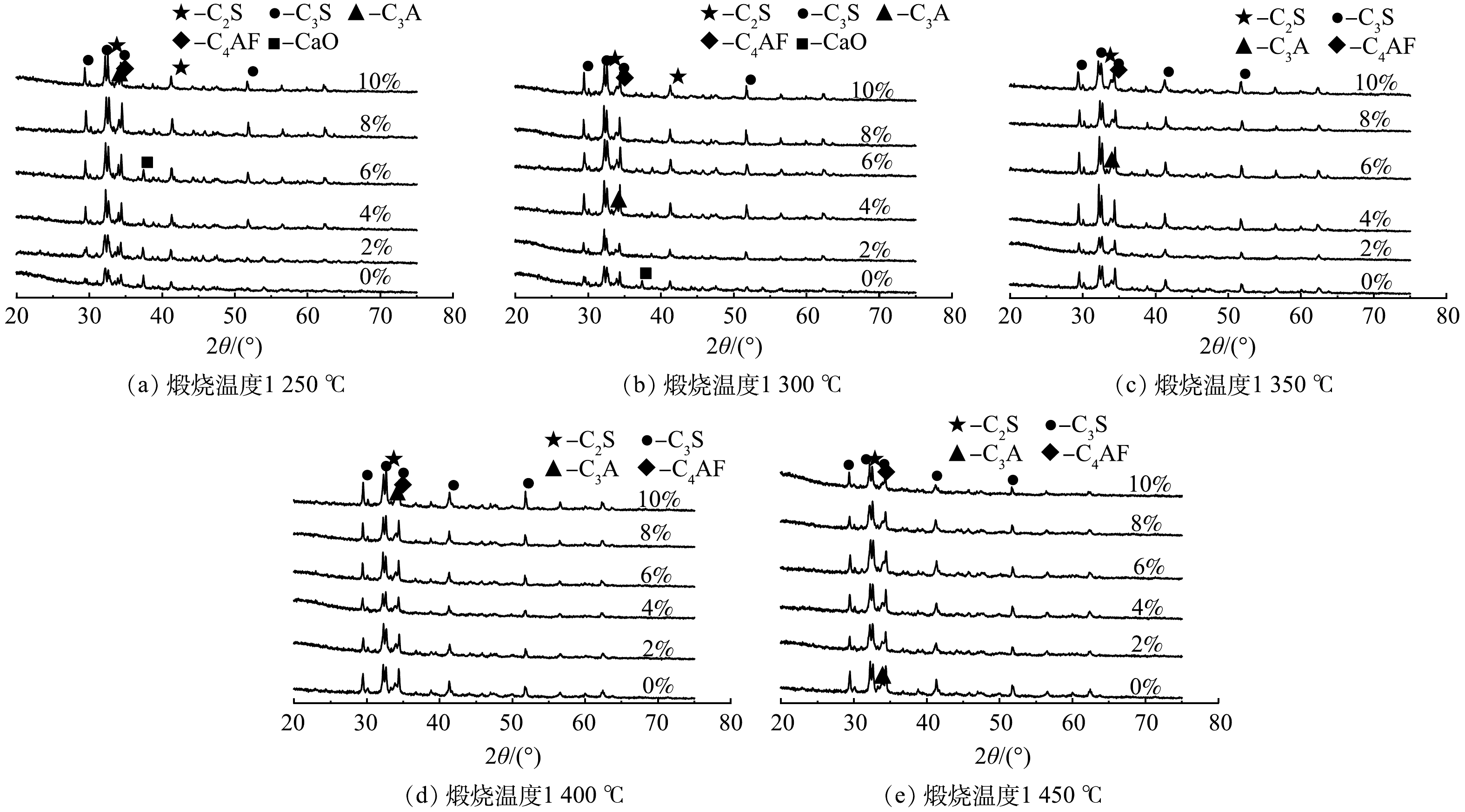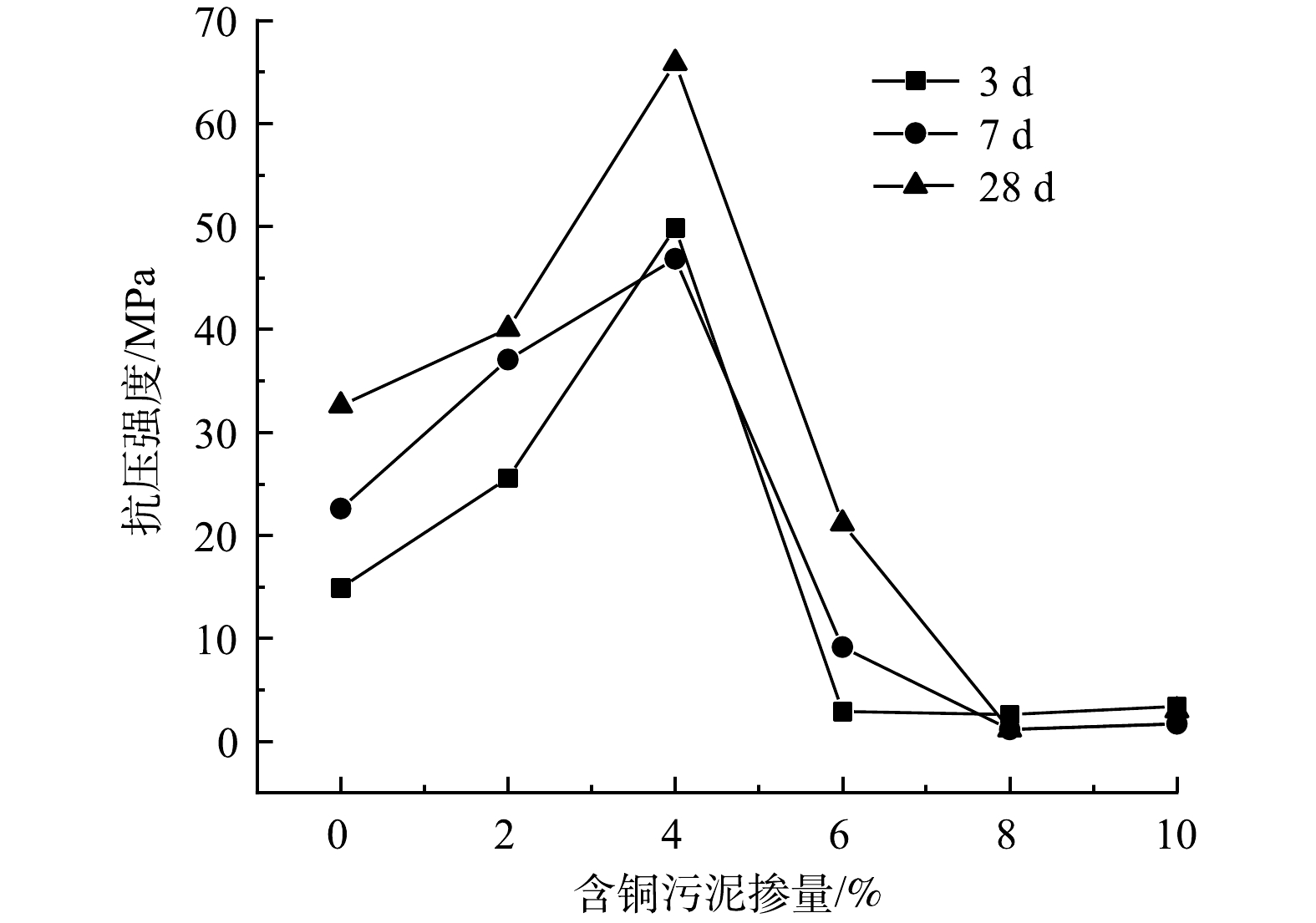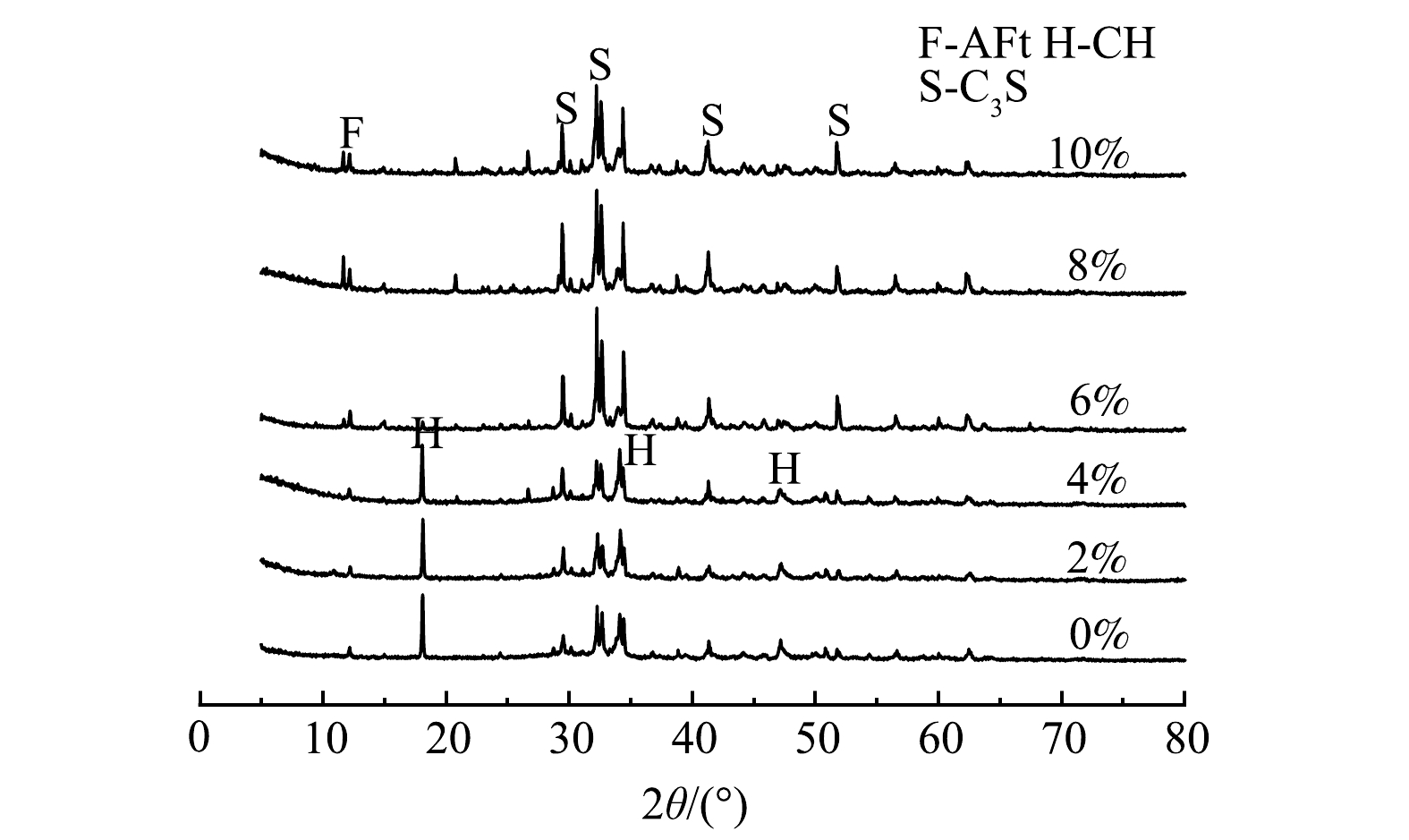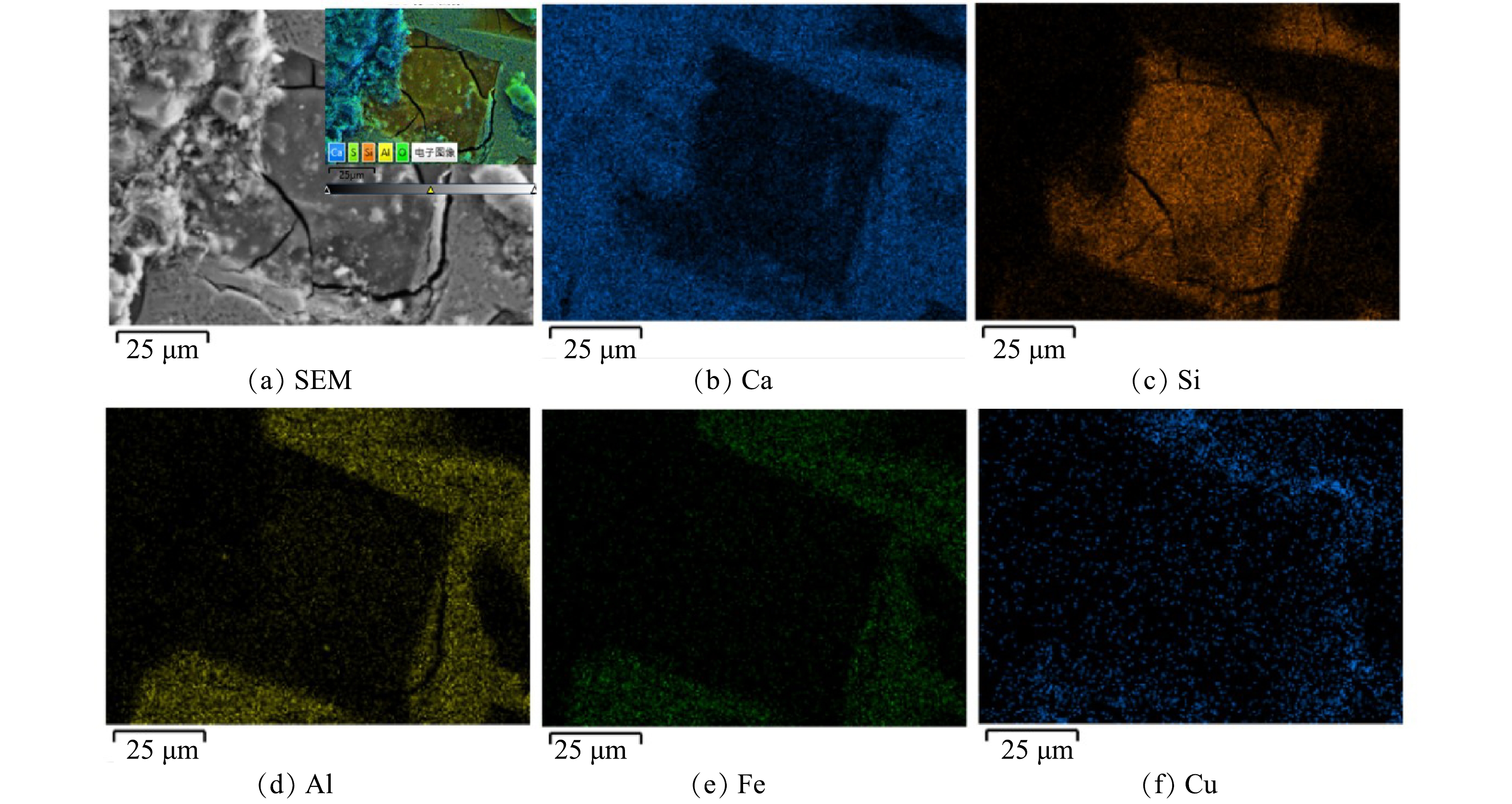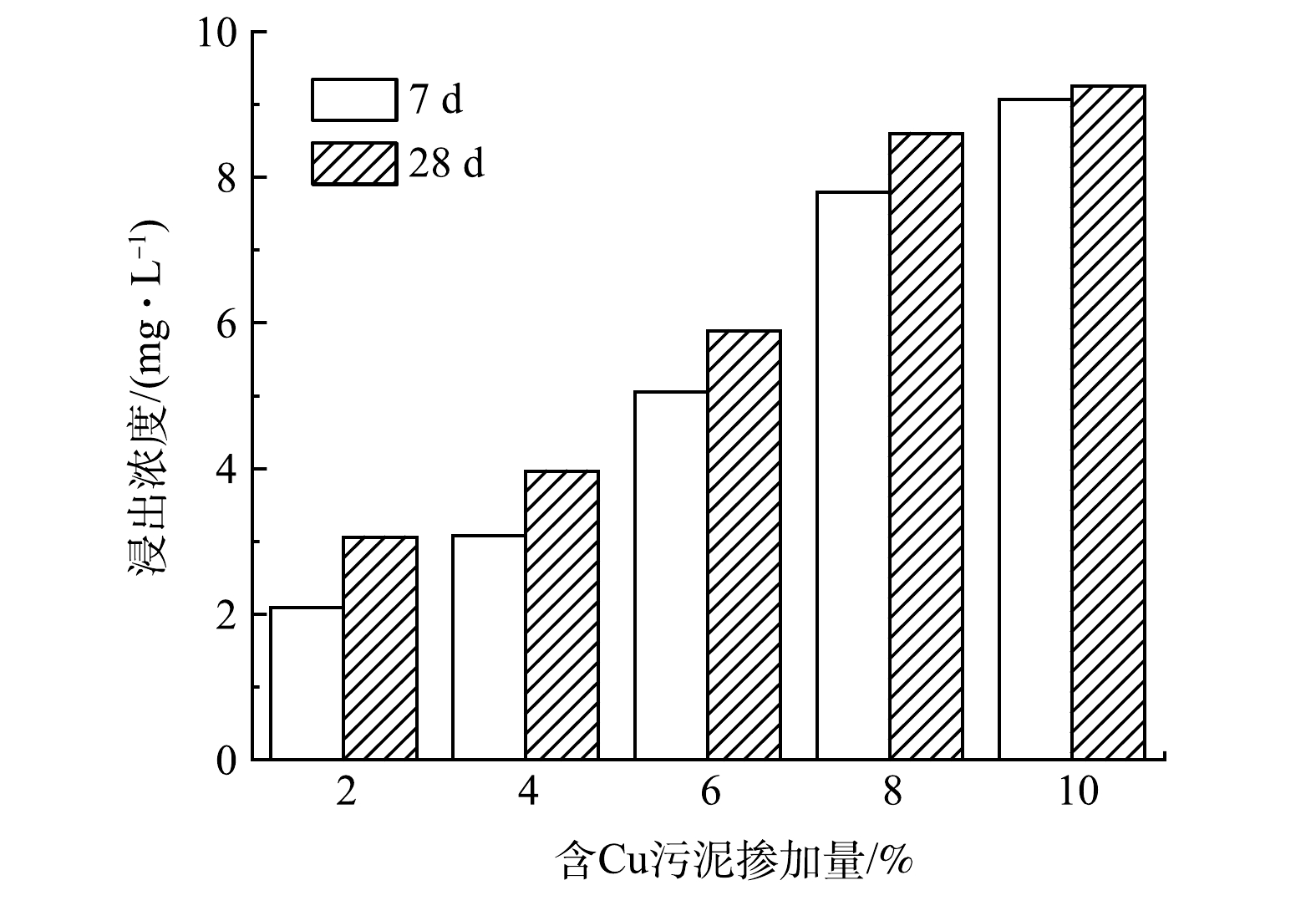-
我国工业生产以及日常生活中产生危险废物的量逐年增加,已对环境造成了极大影响[1-3]。我国半导体行业和集成电路行业每年都会产生大量污泥,这些污泥含有大量铜、镍等重金属[4]。含铜污泥的简单堆积会造成资源浪费,且其含有的重金属和有毒有害物质会随着雨水渗入到地下,对土壤和水体造成污染,继而对人群健康造成威胁[5-7]。研究发现,当人体内的铜过度积累后,会出现生理病变、发育停滞,甚至死亡的后果[8]。为响应危险废物资源化利用和国家碳达峰碳中和的发展要求,含铜污泥的合理处置问题愈发受到重视。
目前,我国对含铜污泥通常采用火法熔炼和集中填埋的处置方式。火法熔炼是通过还原法使污泥中的铜富集回收[9]。但是,含铜污泥铜含量太低,这与传统炼铜原料有较大差距,铜的提炼价值有限;同时,火法熔炼的工艺较为复杂,成本较高,提取重金属之后剩余的杂质还需要进一步处理。集中填埋的缺点是土地占有面积大,有较高的场地和施工成本,且污泥填埋并不能最终避免环境污染[10]。与上述2种方法比较,水泥窑协同处置技术因具有处置对象广、处置规模大、改造成本低、环保指标好等优点,是一种高效经济的处理固体废物的工艺方法[11-15]。水泥回转窑内温度最高可达1 600 ℃,物料在其中停留30 min,可以充分地焚烧固体废物[16-20]。同时,由于我国对水泥、混凝土等基建材料需求巨大,故水泥窑协同处置技术有很好的发展前景。目前,水泥窑协同处置重金属已经被广泛研究。NAVARRO等[21]对普通硅酸盐水泥固化Cu2+进行探索研究,发现Cu2+可被稳定的固化在熟料中。王培铭等[22]研究外掺CuO对熟料矿物相和水化性能的影响,发现掺入适量Cu2+促进C3S形成和C3S晶粒的成长,过量的Cu2+会延缓水化进程。兰明章[23]采用含重金属的危险工业废弃物配制生料烧制水泥熟料,发现掺入的重金属元素绝大部分可以固溶在熟料矿物中。伴随着我国半导体、集成电路行业的飞速发展,含铜污泥的产量增速加快,但目前还没有对含铜污泥行之有效的处置措施。
本研究拟利用水泥窑协同处置含铜污泥,开展含铜污泥的掺入对熟料性能及其中所含重金属对环境安全性的影响的研究。本研究在原始生料中掺入不同量含铜污泥烧制水泥熟料,通过X射线衍射分析(XRD)、电感耦合等离子体质谱(ICP-MS)、f-CaO测定、扫描电镜(SEM-EDS)和分相萃取等测试手段,探索含铜污泥的掺入对水泥熟料的煅烧温度和性能的影响、熟料中重金属的固化及在熟料中的分布情况,以及含铜污泥中重金属浸出浓度的影响。以期在水泥生产过程中更好处置含铜污泥提供参考。
-
实验用水泥生料和含铜污泥均取自陕西省富平县某水泥厂。水泥生料化学组成如表1所示,含铜污泥的化学成分如表2所示。含铜污泥中Cu的质量分数最多,其次还有Fe、Al、Ca和Si等可能影响到熟料烧成性能的元素。
图1为含铜污泥原料XRD图谱。由图1可知,含铜污泥中主要矿物组分是绿铜矿(CuSiO3·H2O)、二硅酸钠(Na2Si2O5)、高岭石(Al2Si2O5(OH)4)、半水石膏(Ca(SO4)(H2O)0.5)和钾明矾(KAl(SO4)2(H2O)12)。其中,主要的Cu元素以绿铜矿(CuSiO3·H2O)的形式存在,Cu离子为正二价。
-
含铜污泥在105 ℃下干燥48 h,冷却后用球磨机磨细混匀后过200目筛备用。含铜污泥在生料中的掺加量为2%、4%、6%、8%和10%。将水泥生料和含铜污泥按比例混好后用行星式球磨机混合1 h。将混合后的物料在15 kN下压成高度为20 mm,直径为40 mm的圆柱体,将样品干燥3 h并放入马弗炉中。以10 ℃·min−1的升温速率从室温升至900 ℃,并保温30 min后,以5 ℃·min−1的速度分别升温到1 250、1 300、1 350、1 400和1 450 ℃,并保温3 h。将烧成后的样品利用风机使其急速冷却至室温,之后研磨直至通过200目筛备用。
将1 450 ℃烧制好的水泥熟料加入质量分数为5%的石膏磨制成比表面积为370 m2·kg−1的粉末,通过0.08 mm的方孔筛,筛余量小于10%,制成水泥。制备好的水泥以0.32的水灰比制成水泥净浆,然后放入20 mm ×20 mm ×20 mm的六联模具中,捣实后在振动台上面震动60 s。在20 ℃,湿度>95%的养护箱养护24 h后脱模,然后标准条件下养护3、7、28 d。用压力机检测试样3、7、28 d龄期的抗压强度。
-
根据《水泥化学分析方法》(GB/T176-2 008)第39条的要求,测定熟料中的游离氧化钙含量;将熟料研磨至20 μm,采用X射线衍射仪(D/MAX 2 200型,日本理学Rikagu公司)对熟料的矿物相进行检测,测试参数为Cu靶Kα线,管流30 mA,管压为40 kV,扫描范围为20°~75°,连续扫描模式,扫描速率为1 (°)·min−1;用场发射扫描电子显微镜(Quanta 200型,美国FEI公司)分析1 450 ℃下烧制的熟料样品做面扫描和能谱分布图,加速电压为20 kV,压强为1.0× e−5 tor,采用低真空模式,样品用环氧树脂封装、磨平并喷金;用液压式压力试验机(JYE-2 000型 无锡建筑材料仪器机械厂)检测之前制备的硅酸盐水泥的3、7、28 d的抗压强度,并取7 d龄期的少量样品用于XRD检测;全消法用HCl-HNO3-HF溶液(HCl:HNO3:HF=3:1:1)对制备的熟料消解,电感耦合等离子体质谱(OPTIMA 8 000DV型,美国帕金埃尔默有限责任公司)检测滤液中重金属的浓度。
分相萃取法。中间相的萃取:称取2 g熟料,湿磨至5 μm,加入SAM溶液(20 g水杨酸和200 mL甲醇溶液),置于30 ℃水浴中搅拌2 h后,静置、过滤、干燥,得到中间相。硅酸盐相萃取:称取3 g熟料,湿磨至5 μm,加入KSOH溶液(10 g KOH和10 g蔗糖溶解在100 mL去离子水中),置于95 ℃水浴中搅拌5 min,静置、过滤、干燥,得到硅酸盐相。用全消法消解提取到的中间相和硅酸盐相,滤液中重金属的浓度通过ICP-MS测定。
浸出实验。将上述制好的7和28 d的式样取少部分,根据《固体废物浸出毒性浸出方法-水平振荡法》(HJ 557-2 010)进行重金属浸出实验,浸出液中重金属浓度用ICP-MS测定。
-
水泥熟料中重金属固化率的计算方法如式(1)所示。
式中:G为固定化率;Loss为烧失量,经计算得0.364;K表示熟料中的Cu离子质量分数,mg·kg−1;S为原料中的Cu离子质量分数,mg·kg−1;K与S值均为实际测量值。
-
1)含铜污泥的加入对生料易烧性的影响。图2是不同煅烧温度下的掺有不同量含铜污泥熟料的f-CaO质量分数的测定结果。随着煅烧温度的升高,熟料中f-CaO的质量分数大幅的降低,最低可降至0.11%。在1 250 ℃时,熟料中f-CaO的质量分数最高。随着含铜污泥的加入,f-CaO质量分数逐渐降低,在污泥掺量为10%时,其f-CaO的质量分数降低为1.25%。在1 300 ℃时,污泥掺量增加到6%时,f-CaO的质量分数由7.04%降低为0.52%,随后掺量增加,f-CaO的质量分数变化基本保持不变。在1 350 ℃时,污泥掺量增加到2%时,f-CaO的质量分数由2.72%降低为0.56%,随后污泥掺量增加对f-CaO质量分数变化影响不明显。在1 400 ℃和1 450 ℃时,含铜污泥的加入对熟料中f-CaO质量分数降低幅度较小,在污泥掺量从2%增加到10%时,f-CaO的质量分数相对稳定,均保持在0.32%以下。
由上述可知含铜污泥的加入可以有效降低熟料中f-CaO的质量分数,且在低温区(<1 350 ℃)时,对熟料中f-CaO的质量分数降低效果最明显。随着温度的升高,熟料烧成品质越好,f-CaO的质量分数降低幅度变小,在1 450 ℃时,基本不随掺量的改变而发生变化。李飞等[24]在生料中加入CuO后在不同温度下煅烧为水泥熟料,结果表明,在相同CuO掺量下,温度越高,CuO可使液相提前出现,降低烧成温度,改善生料易烧性。
2)含铜污泥的加入对熟料矿物相的影响。图3为不同温度下不同含铜污泥掺量的水泥熟料XRD图谱。在1 250 ℃时,掺加含铜污泥后,水泥熟料中C3S、C2S、C4AF矿物相的衍射峰比空白样的都有增强。其中,C3S和C2S的衍射峰增强最为明显;同时,f-CaO的衍射峰随着掺量增加而有所降低。在1 300 ℃时,水泥熟料中的矿物相主要是C3S、C2S、C4AF、C3A和少量的f-CaO。随着含铜污泥掺量的增加,f-CaO衍射峰基本消失不见,而C3S和C2S矿物相的衍射峰仍随着掺量的增加而增强。在1 350 ℃时,熟料中矿物相衍射峰强度变化不大,C3S和C2S矿物相的衍射峰在污泥掺量为8%时,其强度有所下降,但仍高于空白样的强度。在1 400 ℃时,水泥熟料的主要矿物相为C3S和C2S,且随着污泥掺量的增加,各衍射峰的强度呈现缓慢增强的趋势。这说明,此温度下水泥熟料各矿物相生长良好。在1 450 ℃时水泥熟料各矿物相基本稳定,C3S和C2S的衍射峰强度不随污泥掺量的增加而明显改变。这说明,熟料烧制已经完全成型。在污泥掺量为10%时,其C3S和C2S的衍射峰强度有所降低,在高温情况下含铜污泥掺量过多时会影响熟料矿物相的生成。周枫等[25]发现,煅烧温度为1 300 ℃时,适量CuO的加入对易烧性的改善有显著作用,生料中CuO的掺量越大,对C3S的形成越有利。含铜污泥掺入后,所制备的水泥熟料中并未检测到含铜矿物。因此。本研究尚未探究到熟料中Cu的矿物存在形式。但是,通过商得辰[26]的研究可知,CuO掺入熟料后,没有改变熟料中基本的钙离子和硅离子的化学环境,并是以正二价的形式进入到熟料晶体结构或者进入新相CaCuO2中;同时,由于Cu2+与Fe3+半径相差较小,Cu2+更容易取代Fe3+,即倾向于进入C4AF中,形成固溶体。综上可知,本研究中含铜污泥中的铜很可能未达到其自身在熟料矿物中的固溶极限,因此会通过固溶取代的形式进入熟料矿物中,最可能会大量进入熟料铁铝酸盐矿物的结构中。
3)含铜污泥的掺入对熟料力学性能的影响。1 450 ℃下所制硅酸盐水泥的3、7和28 d龄期的抗压强度结果如图4所示。熟料中含铜污泥的掺量从0增加到4%时,3 d抗压强度从14.9 MPa增加到49.85 MPa,增长了234.56%;7 d抗压强度从22.6 MPa增加到46.85 MPa,增长了107.3%;28 d抗压强度从32.6 MPa增加到65.8 MPa,增长了101.8%。当含铜污泥掺量增加到6%时,其3、7和28 d抗压强度分别降低为2.9、9.1和21.1 MPa,与掺量为4%时相比,分别下降了94.2%、83.9%和67.9%。由此可知,少量含铜污泥的加入有利于提高熟料的抗压强度,且增强效果显著;当含铜污泥掺量超过4%后,会使水泥的力学强度迅速降低。
4)含铜污泥对水泥水化产物的影响。1 450 ℃下,不同掺量含铜污泥的硅酸盐水泥的7 d龄期试样XRD结果如图5所示。含铜污泥掺量为0~4%时,水泥净浆的矿物相主要为Ca(OH)2、AFt和部分未水化的C3S,Ca(OH)2的衍射峰强度随着掺量的增加而增强;当污泥掺量为6%—10%时,其矿物相主要是C3S和少量的AFt,Ca(OH)2的衍射峰较弱,水泥水化缓慢,抗压强度降低。这一结果与上述硅酸盐水泥的抗压强度变化情况一致。由此可知,少量含铜污泥的掺入有利于水泥水化反应的进行,当其掺量超过4%后,会明显抑制水泥的水化,劣化水泥水化程度,从而使其力学强度迅速降低。
-
1)熟料扫描电镜分析。由于含铜污泥中重金属Cu所占比例最大,对熟料的影响也更为明显。为了深入探究含铜污泥中Cu元素在水泥熟料矿物相中的分布情况,对1 450 ℃下,对掺量为4%的含铜污泥的熟料样品进行SEM-EDS扫描分析,所得图样如图6所示。图6(a)中的插图表示,图中所示元素分布的重叠部分。由图6(f)可知,Cu在熟料中主要集中分布在Al和Fe富集的区域,少量分布于Si富集的区域;同时,熟料中Al和Fe主要存在于铁铝酸盐相中,Si存在于硅酸盐相中。这说明,Cu主要存在于铁铝酸盐相中,少数存在于硅酸盐相中。
2)熟料分相萃取分析。为了进一步验证上述结果,采用分相萃取法研究含铜污泥中重金属Cu在熟料中的固溶倾向性。用SAM溶液与KSOH溶液分别提取出中间相和硅酸盐相。图7为提取的中间相和硅酸盐相的XRD图谱。图7(a)为熟料的硅酸盐相XRD图谱,图7(b)为熟料的中间相的XRD图谱。图7(a)中,所有的衍射峰只有C3S和C2S;图7(b)中,中间相的衍射峰只有C4AF和C3A,且掺含铜污泥熟料的中间相C4AF衍射峰也高于空白组,这与前文的结果一致。
将提取出来的中间相和硅酸盐相消解,通过ICP-MS检测滤液中重金属离子的浓度,表3为中间相和硅酸盐相的质量分数。掺杂含铜污泥熟料中的中间相中,Cu的质量分数约为22%,硅酸盐相中Cu的质量分数约为77%左右。
表4列出了不同掺量含铜污泥熟料的中间相和硅酸盐相中所固化Cu离子的质量分数。在萃取实验中,将0.1 g的中间相和硅酸盐相溶解在酸中,用ICP-MS检测滤液中的重金属浓度。由表4可知,硅酸盐水泥熟料矿物相中,中间相固化Cu的能力要远大于硅酸盐相固化Cu的能力,这进一步说明了Cu主要分布在熟料的中间相中。
-
1)重金属Cu在水泥熟料中的固化率。本研究发现,Cu主要以Cu2+的形式与Fe3+发生固溶取代反应存在于铁铝酸盐相中。研究了含铜污泥中含量最多的Cu元素在熟料中的固化情况,结果如表5所示。由表5可知,含铜污泥掺量在4%时,Cu离子的固化率最高达到了87%,之后随着含铜污泥掺量的增加,Cu离子的固化率呈下降趋势。随着掺量增加到6%以后,Cu离子的固化率基本稳定在65%左右。Cu离子属于低挥发性金属离子,在理论上固化率接近100%以上[27]。但由于实验室所使用的马弗炉与实际生产所使用的回转窑相比,缺乏负压,密闭的强氧化环境,也不能使物料与原料充分接触,所以在实验中所得的固化率要低于理论值。YANG等[28]用熟料固化Cd和Ni发现,实验室的固化率也远低于工业窑炉。这主要是因为,工业窑炉强的氧化环境、粉尘浓度和气体与原料的接触。
2)Cu离子在水泥净浆中的浸出行为。重金属的浸出浓度是判断水泥窑协同处置后的危险废弃物是否符合环境标准的指标。如图8所示,Cu离子的最大浸出浓度为9.25 mg·L−1,而《危险废物鉴别标准-浸出毒性鉴别》(GB 5085.3-2007)[29]中对Cu离子的浓度限值为100 mg·L−1。所以,水泥窑协同处置含铜污泥在其掺量为10%以下时,熟料中Cu离子的浸出都不会对环境造成威胁。随着含铜污泥的掺量的增加,熟料中Cu离子的质量分数增加,水泥净浆中Cu离子的浸出浓度也随之增加。但随着含铜污泥掺量的增加,净浆中Cu离子的浸出浓度的增长趋势却逐渐减缓;同时,水泥净浆中28 d龄期的Cu离子的浸出浓度均比7 d龄期的浸出浓度要高,但增长幅度不大。这说明,Cu离子可以被很好固化在水泥净浆中,且随着时间的增加,没有大量重金属浸出,不会对环境造成二次污染。水泥窑协同处置含铜污泥技术是可行的。
-
1)含铜污泥的掺入降低了熟料中f-CaO的质量分数,显著改善了水泥熟料的易烧性。在低温煅烧时,对f-CaO质量分数降低最为明显;同时,含铜污泥的掺入可以降低熟料液相的形成温度,从而降低熟料的煅烧温度。
2)含铜污泥掺入会有效促进硅酸盐水泥的水化,使3、7和28 d抗压强度最高可分别达到49.85、46.85和65.8 MPa,当其掺量超过4%后,含铜污泥会明显抑制水泥的水化,劣化水泥水化程度,使其力学强度迅速降低。
3)熟料中Cu离子主要存在于中间相中。Cu离子主要与Fe离子发生固溶取代反应,形成固溶体存在于铁铝酸盐相中,少量分布于硅酸盐矿物相中。
4)含铜污泥中Cu离子在水泥熟料中的固化率随含铜污泥的掺量增加呈先升高后降低的趋势。当含铜污泥掺量为4%时,固化率最高可达到87%。水泥净浆中Cu离子的浸出浓度随含铜污泥的增加而增加,当含铜污泥掺量为10%时,Cu离子的最大浸出浓度为9.25 mg·L−1,说明Cu离子可以有效的被固化在水泥净浆中且不会对环境造成二次污染。
水泥窑协同处置含铜污泥对水泥熟料性能及环境安全性的影响
Effect of Copper-containing sludge co-disposed by cement kiln on properties of cement clinker and its environmental safety
-
摘要: 针对目前没有合理方法处置含铜污泥的问题,利用水泥窑协同处置技术对含铜污泥进行处置,以达到废物资源化的目的。通过掺入不同量的含铜污泥煅烧成水泥熟料,探讨了含铜污泥对硅酸盐水泥熟料性能及其中所含重金属的浸出对环境安全性的影响。结果表明,含铜污泥的加入明显降低了熟料的f-CaO质量分数,改善了水泥生料的易烧性。当含铜污泥掺量为4%及以下时,含铜污泥掺入会有效促进硅酸盐水泥的水化,使3、7和28 d抗压强度最高分别可达到49.85、46.85和65.8 MPa;当其掺量超过4%后,会明显抑制水泥的水化,劣化水泥水化程度,使其力学强度迅速降低。熟料各矿物相对重金属元素的固化具有选择性,含铜污泥中含量最多的Cu主要存在于中间相中,少数分布于硅酸盐相中;含铜污泥中的Cu离子可以有效固化在水泥熟料中,固化率最高可达87%。Cu离子在水泥净浆中的浸出浓度低于工业固体废弃物浸出毒性鉴别标准的规定指标,水泥窑协同处置含铜污泥在使用中不会对环境造成二次污染。本研究结果可为水泥窑协同处置含铜污泥应用提供参考。Abstract: An experimental study to handle Copper-containing sludge by cement kiln technology was presented in the paper. Cement clinker was produced with raw meal after adding various amount of Copper-containing sludge. The effects of copper-containing sludge on the properties of silicate cement clinker and the leaching of heavy metals within the sludge on the environmental safety were discussed. Results indicated that an appreciate amount of Copper-containing sludge as mixed into raw meals would improve its burnability. An proper proportion sludge would not cause clinker’s mineral compositions change, while significantly reducing its f-CaO contents. Depending on the amount of sludge as mixed into the raw meals, Copper-containing sludge had a significant effect on hydration and mechanical strength of the silicate cement. It was found that the Copper-containing sludge would effectively promote the hydration of silicate cement when amount of sludge in raw meal was 4%, resulting in an increase of its compressive strengths, however, cement hydration would deteriorate if amount of sludge exceeded 4.0%, as a result, mechanical strength of silicate cement decreased. Curing of clinker minerals was prone to heavy metal elements, both SEM-EDS images and the split-phase extraction method confirmed that Cu elements were mainly cured as intermediate phase in the cement clinker - this curing rate could reach as high as 87%. The amount of copper ions leached in cement slurry was usually small, lower than the limit as allowed in Standard for industrial solid waste, indicating that Copper ion cured in clink is stable, and would not cause secondary pollution to the environment. This study can provide a reference for cement kiln co-disposal of Copper-containing sludge.
-
Key words:
- copper-containing sludge /
- cement kiln co-disposal /
- solidification /
- compressive strength /
- leaching
-
当前全球人口不断增长,但土壤质量却不断下降,现代文明再次面临粮食危机[1]。过去几十年,污水灌溉、采矿、冶炼、废弃物处理、以及农药、化肥大量使用等人类活动导致土壤重金属积累与超标[2-3],继而影响着农产品安全,威胁着人类健康。土壤治理方法中原位稳定化技术因其具有成本低、见效快、操作简便、对污染点位扰动较小等优势而得到了广泛应用 [4]。但该技术使用的常见修复剂大多存在一定的缺陷,如石灰类材料碱性太强,易造成土壤板结;含磷矿物材料使用不当会间接造成水体污染;黏土矿物成分单一、有效活性组分较低,存在施用量过大等问题 [5]。因此合理选择或开发高效、经济、环境友好的修复剂是原位稳定化技术的关键[6]。
近年来,水铁矿-腐殖酸(Fh-HA)复合材料的制备及应用受到了广大学者的研究[7-9]。相较于单一修复剂而言,复合材料更能满足各种不同要求[10]。多种材料在性能上相互取长补短, 产生协同效应,使复合材料的综合性能往往优于原组成材料[11]。腐殖酸的引入,增加了水铁矿的官能团种类,改变了比表面积,并增大了孔径尺寸;此外,水铁矿在此过程中晶格结构不变,没有向其他铁氧化物转变[12]。腐殖酸仅存在于水铁矿的晶格夹缝间,阻碍水铁矿结晶转化,同时也减缓自身在土壤中的矿化降解[13],因此Fh-HA在稳定土壤重金属方面具有优越的性能。但是腐殖酸在一定条件下,具有较高的溶解性 [14-15],重金属离子在Fh-HA复合物表面的吸附也受到腐殖酸溶解性的影响[16]。自然环境下的酸雨、水淹等现象都可能导致腐殖酸溶解,引起复合材料结构破坏,吸附的重金属再次活化。溶解性腐殖酸与水铁矿的相互作用也会明显增强水铁矿中重金属的释放[17]。若对腐殖酸进行高温改性可使其羟基和羧基等官能团发生脱水反应,增强疏水性,达到不溶的目的[18],从而提高复合材料的稳定性。虽然改性过程减少了腐殖酸可用于吸附重金属的酸性基团,但对于酸性基团的金属络合常数并没有影响[19]。马明广[20]、陈荣平[21]等制备热改性腐殖酸吸附水中重金属,均展现出了高吸附效率,并且不易损失、可以重复利用。由此本文提出一种将腐殖酸高温改性形成不溶性腐殖酸,再与水铁矿结合成更稳定的Fh-IHA复合材料的思路。
目前Fh-IHA对自然环境下碱性土壤重金属的吸附性能以及土壤基本理化性质的影响鲜有研究。然而评价修复材料稳定污染土壤重金属的效果时,不仅要关注重金属有效性,还要关注其本身对土壤基本理化性质的影响。因此本研究以甘肃白银某Cd、Pb污染农田为试验区,进行田间稳定化试验,旨在为重金属污染防控提供一种环境友好的修复材料。主要内容如下:(1)采用高温改性腐殖酸与水铁矿制备成Fh-IHA复合材料,并通过扫描电子显微镜、X射线衍射、傅里叶红外光谱、比表面积与Fh-HA进行表面性能对比分析;(2)经田间稳定化试验,分析Fh-IHA对土壤pH值,有机质,铵态氮、速效磷、有效钾的影响;(3)根据改进BCR法,探讨处理后污染土壤中Cd、Pb的形态变化特征,掌握Fh-IHA对重金属Cd、Pb的稳定规律。
1. 材料与方法(Materials and Methods)
1.1 材料的制备
不溶性腐殖酸:腐殖酸购买于山东西亚化学股份有限公司(C含量为52.9%),将其置于马弗炉,在400 ℃温度下加热1 h,待其自然冷却后用2 mol·L−1 CaCl2溶液浸泡处理,然后抽滤,再用1 mol·L−1 NaNO3溶液和蒸馏水反复洗涤,烘干。最终所得固体为不溶性腐殖酸,储存在密封玻璃瓶中待用[22]。
Fh-HA复合材料(C/Fe=0.5,物质的量比):将FeCl3·6H2O、腐殖酸分别溶于水、NaOH溶液,再将二者混合,然后通过NaOH溶液快速将混合溶液pH调节至7.5。搅拌2 h后,将混合物静置分层后虹吸除去上清液,沉淀物用去离子水清洗离心,最后用真空冷冻干燥机冷冻干燥48 h后密封冷藏于4 ℃条件下备用。
Fh-IHA复合材料(C/Fe=0.5,物质的量比):采用不溶性腐殖酸,其余步骤与制备Fh-HA复合材料相同。
1.2 试验设计
试验田位于甘肃白银某Cd、Pb污染农田,土壤呈碱性,气温低、温差大、降水量少,其基本理化性质见表1。全铅含量为95.47 mg·kg−1,全镉含量为 10.93 mg·kg−1,与《土壤环境质量 农用地污染镉污染风险管控标准(试行)》(GB 15618—2018)相比,该农田属于重度Cd污染、轻微Pb污染。稳定试验在田间进行,分别处理3处半径为0.3 m、深0.6 m的土壤。空白对照(CK)为不添加钝化剂的混合土壤,#1、#2、#3为添加 3 % (W/W)Fh-IHA处理的不同点位土壤。土壤充分混匀后装于Ф10 cm×60 cm的有机玻璃土柱中置于田间稳定化 90 d,土柱上覆盖塑料膜(扎孔通气)进行保湿,期间分别在10、20、30、60、90 d采样,各处理一式三份,密封装袋带回实验室分析。
表 1 土壤基本理化性质Table 1. Basic physical and chemical properties of soilpH 阳离子交换量/(cmol·kg-1)CEC 有机质/(g·kg−1) OM 铵态氮/(mg·kg−1)A-N 有效磷/(mg·kg−1)A-P 速效钾/(mg·kg−1)A-K 镉/(mg·kg-1)Cd 铅/(mg·kg-1)Pb 8.15 8.83 7.55 29.57 42.70 129.42 10.93 95.47 1.3 指标测定方法
Fh-HA与Fh-IHA的微观形貌通过低真空扫描电子显微镜(JSM-5600LV)在6000倍下观察;比表面积是以N2吸附/脱附的BET法用比表面积分析仪(ASAP 2020)测定;傅里叶变换红外光谱在扫描范围为400—4000 cm−1之间,分辨率为8 cm−1下用傅里叶变换红外光谱仪(NEXUS 670)分析;X射线衍射是将样品用玛瑙研钵研磨并过筛后放入药瓶槽内,以(2θ)0.02° 为增量,从(2θ)10° 到80° 用粉末X射线衍射仪(JSM-5600LV)扫描。
土壤pH值采用电位法(HJ 962—2018)以水土比为1:2.5(W/V),室温下剧烈振荡2 min,静止30 min后用pH计测定;土壤有机质采用重铬酸钾滴定法(NY/T 1121.6—2006),以过量重铬酸钾-硫酸溶液氧化0.5 g土壤有机碳,然后用硫酸亚铁滴定消耗量计算;土壤铵态氮、有效磷、速效钾采用联合浸提比色法(NY/T 1848—2010),称取2.5 g风干土样,加入无磷活性炭与土壤联合浸提剂,在25 ℃、220 r·min−1下振荡 10 min过滤,滤液用于测定;土壤Cd和Pb总量是通过向土壤中按体积比5:1:1添加HNO3、HF和H2O2后用微波消解仪(MARS6)消解,然后将消解液用火焰原子吸收光谱仪(ZEEnitt700P)测定;土壤Cd、Pb酸可溶态、可还原态、可氧化态以及残渣态的测定是通过称取1 g风干土样按照改进BCR连续浸提法[23]分步提取。
1.4 数据统计分析
3次重复试验结果的平均值和标准偏差由Microsoft Office Excel 2010计算,并用Origin 2018进行作图。使用SPSS25.0软件进行单因素方差分析,当两组数据间存在显著性差异(P<0.05)时,采用最小显著性差异检验进行多重比较。
2. 结果与讨论(Results and Discussion)
2.1 Fh-IHA与Fh-HA表面性质对比分析
Fh-IHA与Fh-HA的X射线衍射(XRD)图谱如图1所示。两种材料在2θ为35° 和62°附近显示出两个宽峰,与2-线水铁矿的标准衍射卡片(PDF 29—0712)基本一致,表明实验室制备的Fh-IHA与Fh-HA的晶体结构与2-线水铁矿的晶体结构相同,是一种低序的铁(氢)氧化物[24]。由图可以发现,制备的材料没有出现尖锐的衍射峰,峰型相对宽化,表明材料的结晶度较低,这也说明水铁矿没有发生结晶转化,腐殖酸与水铁矿成功复合。对比Fh-HA,Fh-IHA的衍射峰没有明显变化,也没有出现新的峰,说明热改性腐殖酸不会影响复合材料的晶体结构。该结果也得到了Shimizu [25]、Liang 等[26]的证实。经比表面积分析测定,Fh-HA的比表面积为258.9 m2·g−1,经过腐殖酸改性后Fh-IHA的比表面积增加到288.5 m2·g−1。观察扫描电子显微镜(SEM)图(图2)可以看出,比表面积的不同是由于两种复合材料的表面形貌具有明显差异导致。Fh-HA表面呈现出相对规则、光滑的形貌;而Fh-IHA表面更为粗糙,附着有不规则的细小颗粒,因此具有更大的比表面积。优化腐殖酸使复合材料具有更为优越的表面性质,相比凹凸棒石/纳米铁、沸石/纳米零价铁镍、腐殖酸/海泡石等复合材料[27-29],Fh-IHA的比表面积也更大。高比表面积可以使Fh-IHA复合材料暴露更多的功能基团,为重金属提供更多的物理吸附空间和化学吸附活性位点,从而增强吸附重金属的能力[30]。
2.2 Fh-IHA复合材料对实地修复土壤理化性质的影响
土壤的基本理化性质对重金属的活性及植物生长发育起着至关重要的作用[31-32]。在酸性土壤中,常通过添加材料提高土壤pH值,来降低重金属的活性;而对于碱性土壤,pH提高过大会造成土壤过碱,不利于植物生长[33]。本研究中添加Fh-IHA复合材料处理 90 d后,3个土柱中土壤pH值总体上轻微降低。结果如图3a所示,稳定后3个土柱中土壤pH仍为碱性,相比土壤初始pH值,#1号土柱仅微弱变化了0.01个单位(P<0.05),#2、#3号土柱分别降低了0.06和0.16个单位(P<0.05),3个土柱中土壤pH值总体上呈现降低的趋势,但降低幅度相对较小。这一方面可能是由于土壤本身具有一定的酸碱缓冲性[34] ,另一方面主要是水铁矿对H+具有亲和力,而腐殖酸是一种带负电荷的胶体粒子,二者相互作用下一定程度上抵消了对土壤pH的影响[7],因此在碱性土壤中Fh-IHA复合材料不会因为改变土壤的酸碱环境而影响重金属的活性。
有机质是反映土壤肥力的重要特征。图3b显示了添加Fh-IHA复合材料处理90 d后,土壤中有机质含量的变化。与空白对照相比,#1、#2、#3土柱中土壤有机质含量显著变化(P<0.05), 从7.55 g·kg−1分别升高到了9.96、9.24、9.39 g·kg−1。这是因为不溶性腐殖酸本身属于有机物质,材料的添加增加了土壤中有机碳的含量;另一方面Fh-IHA特殊的表面性质可以吸附有机分子胶结土壤粘粒形成团聚体,减少微生物与有机质的接触,起到减缓土壤有机质的降解作用[35]。
Fh-IHA复合材料处理 90 d后,土壤中铵态氮、速效磷、有效钾含量的变化由图3c所示。与空白对照相比,3种养分均呈现出显著降低(P<0.05),3个土柱土壤中铵态氮分别从 29.57 mg·kg−1 降低为22.82、22.21、22.22 mg·kg−1,有效磷含量从42.70 mg·kg−1 降低为9.84、11.60、20.31 mg·kg−1,速效钾含量则由129.42 mg·kg−1 分别降低到82.11、78.08、84.80 mg·kg−1。铵态氮、速效钾中NH4+、K+能与Fh-IHA形成的土壤胶体进行阳离子交换,而有效磷在土壤中多以H2PO4−形式存在,H2PO4−也可通过取代-OH的配体交换而与腐殖酸-铁络合物结合,从而导致3种速效养分变成移动性较小、不易流失的缓效养分[36-37]。因此添加Fh-IHA后土壤中铵态氮、有效磷、速效钾含量呈现出了显著降低。但同时有研究显示在分泌有机酸的植物根系作用以及微生物的活动下,部分缓效养分又可被活化释放[38],表明添加Fh-IHA复合材料有利于土壤中养分的高效利用,促进植物的生长发育。
2.3 Fh-IHA复合材料对实地修复土壤重金属的固定效果分析
2.3.1 Fh-IHA复合材料对Cd、Pb的固定效果
土壤中重金属所赋存的化学形态影响着其迁移能力和生物活性,酸可溶态具有较高活性,容易被植物吸收,而残渣态则已经进入土壤晶体物质的晶格中,即使环境改变一般也难以活化[39],可氧化态与可还原态重金属往往只有在土壤性质发生重大变化时才能在土壤中释放 [40]。本试验研究区域位于西北干旱地区,土壤呈碱性,生物活性较低,自然环境相对稳定,由此本研究将可还原态、可氧化态与残渣态统一归为稳定态,以酸可溶态为活性态。添加Fh-IHA复合材料处理90 d后土壤中活性态Cd百分比含量明显降低,稳定态Cd含量升高,稳定效果显著(P<0.05)。具体结果如图4a所示,与空白对照相比,3个土柱中土壤活性态Cd百分比含量分别为45.2%、45.1%、51.1%,显著降低了25.9%—31.9%,降幅达到33.6%—41%;稳定态Cd百分比含量显著增加了22.1%—34.0%,增幅达到96%—148%。具体而言,未经处理情况下土壤中Cd化学形态主要集中在酸可溶态,占总Cd含量的77.0%。经Fh-IHA复合材料处理90 d后,各土柱Cd赋存形态具体表现为酸可溶态与可氧化态转化为可还原态与残渣态,可氧化态Cd由5.1%降低到了0.9%—1.4%,可还原态与残渣态Cd分别由9.7%、8.3%增加到了18.7%—19.2%与34.4%—38.5%。温鑫[41]研究了腐殖酸、有机肥、沸石、海泡石、硅藻土等多种材料单一以及组合添加处理Cd污染土壤,最佳效果为活性态Cd降低2.01%—3.35%,其中腐殖酸单一添加甚至对土壤Cd产生了活化作用。相比之下,Fh-IHA复合材料对土壤中Cd展现出更好的稳定效果,这可能是因为复合材料同时具有多重稳定机制,并且可以弥补单一或组配添加下材料本身存在的缺陷。而腐殖酸既能促进也能抑制土壤Cd的活性[14],这是因为腐殖酸含有多种活性官能团,可与重金属结合,但同时自然环境下腐殖酸不够稳定,容易被矿化分解为有机酸,即使在高pH下也能促进土壤中Cd的释放[42],这也正是腐殖酸需要进行改性的原因之一。
Fh-IHA复合材料处理90 d后土壤中活性态Pb百分比含量明显降低,稳定态Pb含量明显升高,稳定效果显著(P<0.05)。结果如图4b所示,与空白对照相比,3个土柱中活性态Pb百分比含量分别降低为7.4%、12.2%、6.4%,显著降低了9.2%—15%,降幅达到43.0%—70.1%;稳定态Pb百分比含量显著增加了15.6%—21.4%,增幅达到19.8—27.2%。具体而言,土壤中Pb各形态百分比含量与Cd展现出了不同的情形,在未经处理情况下,Pb主要集中在可还原态,占总含量的72.2%,而酸可溶态Pb仅占总含量的21.4%。经Fh-IHA复合材料处理90 d后,3个土柱具体表现为由酸可溶态与可还原态Pb转化为可氧化态与残渣态Pb,可还原态Pb由72.2%降低至46.8%—50.4%,可氧化态Pb呈现不规律的变化,残渣态Pb由1.8% 增加到了36.5%—39.4%。在土壤Pb稳定化方面,袁兴超等[43]分别在大田与盆栽环境下研究了钙镁磷肥、生物炭、石灰、腐殖酸、海泡石对Pb形态的影响,结果表明对残渣态Pb稳定效果较好的石灰与生物炭分别增加23.7%、20.8%。而本研究在Fh-IHA处理下残渣态Pb由1.8%显著增加到了36.5%—39.4%,表明Fh-IHA对Pb也同样具有较好的稳定效果,可同时应用于治理Cd、Pb复合污染土壤。Fh-IHA复合材料处理10 d后土壤Cd、Pb的各化学形态变化就基本稳定(图5),之后在长达90 d的监测中土壤Cd浓度保持不变,土壤Pb呈现出由活性态Pb向稳定态Pb轻微转化的趋势。 Cd、Pb均未见活化迹象,三个土柱表现基本一致。现阶段大量的重金属稳定研究监测时间在60 d以内[44-46],庞瑜[8]、赵立芳[47]分别在30和60 d的监测下验证了Fh-HA对土壤Cd、Pb的钝化效果,但部分处理出现了活化现象。这证明优化后的Fh-IHA复合材料具有较高的稳定性,充分表明了Fh-IHA可作为一种固定土壤中Cd、Pb重金属的理想稳定剂。
2.3.2 Fh-IHA复合材料对Cd、Pb的稳定作用
傅里叶红外光谱(FTIR)可用来显示物质中涉及的主要键的特征吸收带,Fh-IHA复合材料的分析结果如图6所示。通过对比红外特征谱图库中化学键的特征波数,Fh-IHA在916.1 cm−1与692.3 cm−1处出现特征峰,这归因于Fe—OH和Fe—O键的伸缩振动,对应水铁矿表面羟基及氧配位根[48],而 539.9 cm−1 和 470.6cm−1处特征峰,则表明存在芳族C—H的平面外弯曲振动,1103.1 cm−1为羟基的C—O振动,1376.9 cm−1处为醇O—H的弯曲振动、1587.2 cm−1处为C=C伸缩振动,1701.1 cm−1处为羧基中的C=O伸缩振动,3403.8 cm−1、3695.4 cm−1处主要为O—H与N—H的伸缩振动。Fh-IHA复合材料相比水铁矿的红外光谱图[49]具有更多的特征峰,增加的特征峰主要由不溶性腐殖酸结构中羧基、醇羟基、酚羟基以及氨基等官能团结构上的特殊化学键产生,而活性官能团可通过吸附、络合等作用与环境中的重金属离子形成配位化合物[16]。不同的官能团与金属离子之间的结合能力不同,腐殖酸与重金属离子之间的作用基团,最主要的是酚羟基和羧基[50]。此外,铁(氢)化物表面大量的两性基团通过去质子化作用形成的可变电荷也可与重金属离子发生表面配合,产生吸附[16]。Fh-IHA复合材料由不溶性腐殖酸与水铁矿复合而成,因此能够实现两种交互作用方式,水铁矿、不溶性腐殖酸通过表面络合、静电吸附作用结合Cd2+、Pb2+,从而达到有效降低土壤中活性态Cd、Pb的目的。其可能的稳定作用过程由图7所示。
3. 结论(Conclusion)
(1)Fh-IHA复合材料表面性质优越,是良好的重金属稳定材料。优化后的Fh-IHA仍保持2-线水铁矿的晶体特征,结构稳定。与Fh-HA相比,Fh-IHA具有更粗糙的表面和更大的比表面积,可以提供更多的吸附空间和活性位点,有利于稳定Cd、Pb重金属。
(2)Fh-IHA复合材料添加到碱性重金属污染土壤中,有利于改善土壤理化性质。经田间试验显示,添加Fh-IHA后土壤pH轻微降低,土壤有机质含量显著提高,并促进土壤中铵态氮、有效磷、速效钾的固存,减少了土壤中速效养分的流失。
(3)Fh-IHA复合材料能有效降低土壤中Cd、Pb重金属的活性,且见效快、稳定性高。Fh-IHA通过丰富的活性官能团与土壤中Cd2+、Pb2+发生表面络合、静电吸附作用,使得土壤中稳定态Cd、Pb百分比含量显著升高了22.1%—34.0%、15.6%—21.4%,可作为一种环境友好的土壤重金属污染修复材料。
-
表 1 生料化学组成
Table 1. Chemical compositions a of cement raw material (calculated by mass fraction)
% CaO SiO2 Fe2O3 Al2O3 MgO K2O P2O5 Na2O 42.75 13.96 2.35 3.33 0.97 0.932 2.46 1.42 表 2 含铜污泥化学组成
Table 2. Contents of chemical components in copper-containing sludge (calculated by mass fraction)
% CuO SO3 SiO2 Al2O3 CaO Fe2O3 K2O TiO2 其他杂质 39.69 25.45 12.57 10.8 1.82 0.796 0.057 0.054 8.76 表 3 掺含铜污泥熟料的中间相和硅酸盐相的质量分数
Table 3. Content of intermediate and silicate phases of clinker mixed with copper-containing sludge
样品编号 含铜污泥掺量/% Cu的质量/g Cu的质量分数/% 熟料 中间相 硅酸盐相 中间相 硅酸盐相 R-I 0 2.016 0.424 — 21.05 — R-S 0 3.022 — 2.344 77.56 C1-I 2.0 2.014 0.427 — 21.24 — C2-I 4.0 2.025 0.432 — 21.52 — C3-I 6.0 2.032 0.439 — 22.11 — C4-I 8.0 2.018 0.433 — 22.46 — C5-I 10.0 2.023 0.430 — 22.55 — C1-S 2.0 3.015 — 2.330 — 77.28 C2-S 4.0 3.014 — 2.332 — 77.37 C3-S 6.0 3.020 — 2.336 — 77.20 C4-S 8.0 3.011 — 2.338 — 77.65 C5-S 10.0 3.022 — 2.338 — 77.37 注:样品编号中,R为空白组、C为掺加含铜污泥的样品组、I为中间相、S为硅酸盐相。 表 4 中间相和硅酸盐相中Cu离子的质量分数
Table 4. Content of heavy metal in different phases of clinker
样品编号 含铜污泥掺量/% Cu离子固化质量分数/ (mg·kg-1) 中间相 硅酸盐相 C1 2.0 18 124.22 1 582.72 C2 4.0 39 655.38 3 246.35 C3 6.0 62 571.89 4 986.77 C4 8.0 78 542.90 6 650.88 C5 10.0 99 852.05 8 462.26 表 5 Cu离子在熟料中的固化率
Table 5. Solidification rate of Cu ion in cement clinker
样品编号 含铜污泥掺量/% Cu离子质量分数/(mg·kg−1) 固化率/% 原料中 熟料中 C1 2% 3 456.68 4 184.97 77 C2 4% 5 015.62 6 860.99 87 C3 6% 8 420.77 9 135.75 69 C4 8% 12 062.60 12 517.79 66 C5 10% 13 430.99 13 726.64 65 -
[1] 任志盛, 刘数华. 重金属污染土壤修复研究进展[J]. 硅酸盐通报, 2021, 40(6): 2042-2051. [2] 黄占斌, 李昉泽. 土壤重金属固化稳定化的环境材料研究进展[J]. 中国材料进展, 2017, 36(11): 840-851. [3] 严梅. 金属矿区重金属污染评价分析[J]. 中国资源综合利用, 2021, 39(4): 148-150. doi: 10.3969/j.issn.1008-9500.2021.04.044 [4] 李红艺, 刘伟京, 陈勇, 等. 电镀污泥中铜和镍的回收和资源化技术[J]. 中国资源综合利用, 2005(12): 7-10. doi: 10.3969/j.issn.1008-9500.2005.12.007 [5] 周瑞生, 刘红芳. 含铜工业污泥无害化资源化处理技术探讨[J]. 有色冶金设计与研究, 2021, 42(3): 42-44. [6] SIYAL A A, SHAMSUDDIN M R, KHAN M. I, et al. A review on geopolymers as emerging materials for the adsorption of heavy metals and dyes[J]. Journal of Environmental Management, 2018, 224: 327-329. [7] HUANG H M, LIU J H, ZHANG P, et al. Investigation on the simultaneous removal of fluoride, ammonia nitrogen and phosphate from semiconductor wastewater using chemical precipitation[J]. Chemical Engineering Journal, 2017, 307: 696-706. doi: 10.1016/j.cej.2016.08.134 [8] 王夏芳. 铜离子对环境危害现状及对策研究[J]. 国土与自然资源研究, 2015(1): 55-57. doi: 10.3969/j.issn.1003-7853.2015.01.018 [9] WOOD, JACOB, HUGHES, et al. Energy efficiency of the Outotec (R) ausmelt process for primary copper smelting[J]. Jom, 2017, 69(6). [10] DIAMANTIS V, ERGUDER T H, AIVASIDIS A, et al. Wastewater disposal to landfill-sites: A synergistic solution for centralized management of olive mill wastewater and enhanced production of landfill gas[J]. Journal of Environmental Management, 2013, 128: 427-434. doi: 10.1016/j.jenvman.2013.05.051 [11] 郝艳, 任连海, 王攀, 等. 国内外城市固体废弃物处理技术与模式[J]. 绿色科技, 2013(12): 143-145. doi: 10.3969/j.issn.1674-9944.2013.12.059 [12] 葛亚男, 张弛, 袁进, 等. 水泥窑协同处置危险废物的环境影响研究[J]. 安全与环境工程, 2021, 28(4): 201-206. [13] ANYA V P, BRAMESHUBER W G. Binding and leaching of trace elements in Portland cement pastes[J]. Cement and Concrete Research, 2016, 79: 92. [14] VORADA K, WEN Z G, ZHENG K F, et al. Municipal solid waste (MSW) co-processing in cement kiln to relieve China's Msw treatment capacity pressure[J]. Resources, Conservation and Recycling, 2021: 167. [15] 王益峰, 祝红梅, 蒋旭光, 等. 水泥窑协同处置危险废物的研究现状及其发展[J]. 环境污染与防治, 2018, 40(8): 943-949. [16] 惠家状. 我国利用水泥窑协同处置污染物的现状及展望[J]. 中国水泥, 2021(2): 85-87. [17] 水泥窑协同处置固废技术展望[A]. 中国水泥协会环保和资源综合利用专业委员会、中国硅酸盐学会环境保护分会[J]. 第九届中国水泥行业环资高峰论坛-暨水泥企业绿色高质量发展研讨会文集[C]//中国水泥协会环保和资源综合利用专业委员会、中国硅酸盐学会环境保护分会:中国硅酸盐学会, 2020: 7. [18] 张江. 水泥熟料固化危险工业废弃物中重金属元素的研究[D]. 北京: 北京工业大学, 2004. [19] WEI C, HONG J L, XU C Q, et al. Pollutants generated by cement production in China, their impacts, and the potential for environmental improvement[J]. Journal of Cleaner Production, 2015, 103: 61-69. doi: 10.1016/j.jclepro.2014.04.048 [20] KIM H T, LEE T G. A simultaneous stabilization and solidification of the top five most toxic heavy metals (Hg, Pb, As, Cr, and Cd)[J]. Chemosphere, 2017, 178: 479-485. doi: 10.1016/j.chemosphere.2017.03.092 [21] NAVARRO A, CARDELLACH E, CORBELLA M, et al. Immobilization of Cu, Pb and Zn in mine-contaminated soils using reactive materials[J]. Journal of Hazardous Materials, 2011, 186(2-3): 1576-1585. doi: 10.1016/j.jhazmat.2010.12.039 [22] 王培铭, 李好新, 吴建国, 等. 不同氧化铜掺量下硅酸三钙矿物的形成(英文)[J]. 硅酸盐学报, 2007(10): 1353-1358. doi: 10.3321/j.issn:0454-5648.2007.10.016 [23] 兰明章. 重金属在水泥熟料煅烧和水泥水化过程中的行为研究[D]. 北京: 中国建筑材料科学研究总院, 2008. [24] 李飞, 杨雷, 管学茂, 等. CuO对水泥熟料烧成及矿物组分的影响[J]. 水泥, 2010(9): 11-12. doi: 10.3969/j.issn.1002-9877.2010.09.003 [25] 周枫, 王玉江, 张战营, 等. CuO对水泥熟料烧成及C3S形成动力学的影响[J]. 河南科技大学学报(自然科学版), 2011, 32(3): 5-8. [26] 商得辰. 重金属离子在水泥熟料中的固化行为及作用机理研究[D]. 武汉: 武汉理工大学, 2017. [27] KOLOVOS K, TSIVILIS S, KAKALI G, et al. The effect of foreign ions on the reactivity of the CaO-SiO2-Al2O3-Fe2O3 system Part II: Cations[J] Cement and Concrete Research, 2002, 32: 463-469. [28] YANG Y, XUE J, HUANG Q, et al. Studies on the solidification mechanisms of Ni and Cd in cement clinker during cement kiln co-processing of hazardous wastes[J]. Construction and Building Materials, 2014, 57: 138-143. doi: 10.1016/j.conbuildmat.2013.12.081 [29] 国家环境保护总局, 国家质量监督检验检疫总局. 废物鉴别标准 浸出毒性鉴别: GB 5085.3-2007[S]. 北京: 中国环境科学出版社, 2007. -






 DownLoad:
DownLoad:


